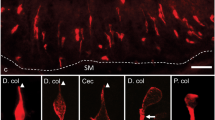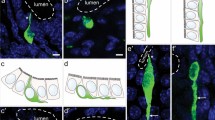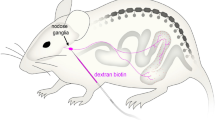Abstract
In the gastrointestinal (GI) tract, a variety of digestive processes are continually adapted to the changing composition of ingested foods, which requires a precise chemosensory monitoring of luminal contents. Gustducin-expressing brush cells scattered throughout the GI mucosa are considered candidate sensory cells for accomplishing this task. In this study, we have investigated a large cluster of gustducin-positive cells which is located exactly at the boundary between the fundic and the oxyntic mucosa of the mouse stomach, at the so-called “limiting ridge”. In close association with the candidate chemosensory cluster, we found two populations of enteroendocrine cells: one population containing the satiety regulating hormone ghrelin, the other population comprising serotonin-secreting enterochromaffin cells. The particular arrangement of gustducin-expressing cells and enteroendocrine cells at the limiting ridge suggests a direct interplay between these cell types with immediate implications, not only for digestive processes in the stomach, but also for parameters controlling the satiety status.









Similar content being viewed by others

Abbreviations
- CV:
-
Circumvallate papilla
- EC cells:
-
Enterochromaffin cells
- ECL cells:
-
Enterochromaffin-like cells
- GI:
-
Gastrointestinal
- GLP-1:
-
Glucagon-like peptide-1
- 5-HT:
-
5-Hydroxytryptamin
References
Berthoud HR, Kressel M, Raybould HE, Neuhuber WL (1995) Vagal sensors in the rat duodenal mucosa: distribution and structure as revealed by in vivo DiI-tracing. Anat Embryol (Berl) 191(3):203–212
Bezencon C, le Coutre J, Damak S (2007) Taste-signaling proteins are coexpressed in solitary intestinal epithelial cells. Chem Senses 32(1):41–49
Chandrashekar J, Mueller KL, Hoon MA, Adler E, Feng L, Guo W, Zuker CS, Ryba NJ (2000) T2Rs function as bitter taste receptors. Cell 100(6):703–711
Chou HC, Chien CL, Lu KS (2001) The distribution of PGP9.5, BDNF and NGF in the vallate papilla of adult and developing mice. Anat Embryol (Berl) 204(2):161–169
Covington DK, Briscoe CA, Brown AJ, Jayawickreme CK (2006) The G-protein-coupled receptor 40 family (GPR40–GPR43) and its role in nutrient sensing. Biochem Soc Trans 34(Pt 5):770–773
Cummings DE, Foster-Schubert KE, Overduin J (2005) Ghrelin and energy balance: focus on current controversies. Curr Drug Targets 6(2):153–169
Debas HT (1987) Gastrin. Clin Invest Med 10(3):222–225
Dockray G, Dimaline R, Varro A (2005) Gastrin: old hormone, new functions. Pflugers Arch 449(4):344–355
Dumoulin V, Moro F, Barcelo A, Dakka T, Cuber JC (1998) Peptide YY, glucagon-like peptide-1, and neurotensin responses to luminal factors in the isolated vascularly perfused rat ileum. Endocrinology 139(9):3780–3786
Dyer J, Vayro S, King TP, Shirazi-Beechey SP (2003) Glucose sensing in the intestinal epithelium. Eur J Biochem 270(16):3377–3388
Dyer J, Salmon KS, Zibrik L, Shirazi-Beechey SP (2005) Expression of sweet taste receptors of the T1R family in the intestinal tract and enteroendocrine cells. Biochem Soc Trans 33(Pt 1):302–305
Finger TE, Bottger B, Hansen A, Anderson KT, Alimohammadi H, Silver WL (2003) Solitary chemoreceptor cells in the nasal cavity serve as sentinels of respiration. Proc Natl Acad Sci USA 100(15):8981–8986
Gershon MD (2004) Review article: serotonin receptors and transporters––roles in normal and abnormal gastrointestinal motility. Aliment Pharmacol Ther 20(Suppl 7):3–14
Gershon MD, Tack J (2007) The serotonin signaling system: from basic understanding to drug development for functional GI disorders. Gastroenterology 132(1):397–414
He W, Yasumatsu K, Varadarajan V, Yamada A, Lem J, Ninomiya Y, Margolskee RF, Damak S (2004) Umami taste responses are mediated by alpha-transducin and alpha-gustducin. J Neurosci 24(35):7674–7680
Hirasawa A, Tsumaya K, Awaji T, Katsuma S, Adachi T, Yamada M, Sugimoto Y, Miyazaki S, Tsujimoto G (2005) Free fatty acids regulate gut incretin glucagon-like peptide-1 secretion through GPR120. Nat Med 11(1):90–94
Höfer D, Drenckhahn D (1996) Cytoskeletal markers allowing discrimination between brush cells and other epithelial cells of the gut including enteroendocrine cells. Histochem Cell Biol 105(5):405–412
Höfer D, Puschel B, Drenckhahn D (1996) Taste receptor-like cells in the rat gut identified by expression of alpha-gustducin. Proc Natl Acad Sci USA 93(13):6631–6634
Hunt JN, Stubbs DF (1975) The volume and energy content of meals as determinants of gastric emptying. J Physiol 245(1):209–225
Itoh Y, Kawamata Y, Harada M, Kobayashi M, Fujii R, Fukusumi S, Ogi K, Hosoya M, Tanaka Y, Uejima H, Tanaka H, Maruyama M, Satoh R, Okubo S, Kizawa H, Komatsu H, Matsumura F, Noguchi Y, Shinohara T, Hinuma S, Fujisawa Y, Fujino M (2003) Free fatty acids regulate insulin secretion from pancreatic beta cells through GPR40. Nature 422(6928):173–176
Kanazawa H, Yoshie S (1996) The taste bud and its innervation in the rat as studied by immunohistochemistry for PGP 9.5. Arch Histol Cytol 59(4):357–367
Kellum JM Jr, Jaffe BM (1976) Release of immunoreactive serotonin following acid perfusion of the duodenum. Ann Surg 184(5):633–636
Khanna MU, Abraham P (1990) Determinants of acid secretion. J Assoc Physicians India 38(Suppl 1):727–730
Le Poul E, Loison C, Struyf S, Springael JY, Lannoy V, Decobecq ME, Brezillon S, Dupriez V, Vassart G, Van Damme J, Parmentier M, Detheux M (2003) Functional characterization of human receptors for short chain fatty acids and their role in polymorphonuclear cell activation. J Biol Chem 278(28):25481–25489
Li X, Staszewski L, Xu H, Durick K, Zoller M, Adler E (2002) Human receptors for sweet and umami taste. Proc Natl Acad Sci USA 99(7):4692–4696
Luciano L, Reale E (1992) The “limiting ridge” of the rat stomach. Arch Histol Cytol 55(Suppl):131–138
Mace OJ, Affleck JA, Patel N, Kellett GL (2007) Sweet taste receptors in rat small intestine stimulate glucose absorption through apical GLUT2. J Physiol 582(Pt 1):379–392
Matsumura S, Mizushige T, Yoneda T, Iwanaga T, Tsuzuki S, Inoue K, Fushiki T (2007) GPR expression in the rat taste bud relating to fatty acid sensing. Biomed Res 28(1):49–55
Mei N (1985) Intestinal chemosensitivity. Physiol Rev 65(2):211–237
Nelson G, Hoon MA, Chandrashekar J, Zhang Y, Ryba NJ, Zuker CS (2001) Mammalian sweet taste receptors. Cell 106(3):381–390
Nelson G, Chandrashekar J, Hoon MA, Feng L, Zhao G, Ryba NJ, Zuker CS (2002) An amino-acid taste receptor. Nature 416(6877):199–202
Ormsbee HS 3rd, Fondacaro JD (1985) Action of serotonin on the gastrointestinal tract. Proc Soc Exp Biol Med 178(3):333–338
Popovic V, Duntas LH (2005) Brain somatic cross-talk: ghrelin, leptin and ultimate challengers of obesity. Nutr Neurosci 8(1):1–5
Raybould HE, Zittel TT (1995) Inhibition of gastric motility induced by intestinal glucose in awake rats: role of Na(+)-glucose co-transporter. Neurogastroenterol Motil 7(1):9–14
Rindi G, Leiter AB, Kopin AS, Bordi C, Solcia E (2004) The “normal” endocrine cell of the gut: changing concepts and new evidences. Ann N Y Acad Sci 1014:1–12
Robert A (1971) Proposed terminology for the anatomy of the rat stomach. Gastroenterology 60(2):344–345
Roper SD (2006) Cell communication in taste buds. Cell Mol Life Sci 63(13):1494–1500
Rössler P, Kroner C, Freitag J, Noe J, Breer H (1998) Identification of a phospholipase C beta subtype in rat taste cells. Eur J Cell Biol 77(3):253–261
Rozengurt N, Wu SV, Chen MC, Huang C, Sternini C, Rozengurt E (2006) Colocalization of the alpha-subunit of gustducin with PYY and GLP-1 in L cells of human colon. Am J Physiol Gastrointest Liver Physiol 291(5):G792–G802
Salehi A, Flodgren E, Nilsson NE, Jimenez-Feltstrom J, Miyazaki J, Owman C, Olde B (2005) Free fatty acid receptor 1 (FFA(1)R/GPR40) and its involvement in fatty-acid-stimulated insulin secretion. Cell Tissue Res 322(2):207–215
Spielman AI (1998) Gustducin and its role in taste. J Dent Res 77(4):539–544
Sugita M (2006) Taste perception and coding in the periphery. Cell Mol Life Sci 63(17):2000–2015
Sutherland K, Young RL, Cooper NJ, Horowitz M, Blackshaw LA (2007) Phenotypic characterization of taste cells of the mouse small intestine. Am J Physiol Gastrointest Liver Physiol 292(5):G1420–G1428
Takeda N, Hasegawa S, Morita M, Matsunaga T (1993) Pica in rats is analogous to emesis: an animal model in emesis research. Pharmacol Biochem Behav 45(4):817–821
Tassone F, Broglio F, Gianotti L, Arvat E, Ghigo E, Maccario M (2007) Ghrelin and other gastrointestinal peptides involved in the control of food intake. Mini Rev Med Chem 7(1):47–53
Thompson RJ, Doran JF, Jackson P, Dhillon AP, Rode J (1983) PGP 9.5––a new marker for vertebrate neurons and neuroendocrine cells. Brain Res 278(1–2):224–228
Tomasetto C, Karam SM, Ribieras S, Masson R, Lefebvre O, Staub A, Alexander G, Chenard MP, Rio MC (2000) Identification and characterization of a novel gastric peptide hormone: the motilin-related peptide. Gastroenterology 119(2):395–405
Wakisaka S, Miyawaki Y, Youn SH, Kato J, Kurisu K (1996) Protein gene-product 9.5 in developing mouse circumvallate papilla: comparison with neuron-specific enolase and calcitonin gene-related peptide. Anat Embryol (Berl) 194(4):365–372
Wattel W, Geuze JJ (1978) The cells of the rat gastric groove and cardia. An ultrastructural and carbohydrate histochemical study, with special reference to the fibrillovesicular cells. Cell Tissue Res 186(3):375–391
Wong GT, Gannon KS, Margolskee RF (1996) Transduction of bitter and sweet taste by gustducin. Nature 381(6585):796–800
Wren AM, Bloom SR (2007) Gut hormones and appetite control. Gastroenterology 132(6):2116–2130
Wu SV, Rozengurt N, Yang M, Young SH, Sinnett-Smith J, Rozengurt E (2002) Expression of bitter taste receptors of the T2R family in the gastrointestinal tract and enteroendocrine STC-1 cells. Proc Natl Acad Sci USA 99(4):2392–2397
Yamamoto K, Matsunaga S, Matsui M, Takeda N, Yamatodani A (2002) Pica in mice as a new model for the study of emesis. Methods Find Exp Clin Pharmacol 24(3):135–138
Zhang Y, Hoon MA, Chandrashekar J, Mueller KL, Cook B, Wu D, Zuker CS, Ryba NJ (2003) Coding of sweet, bitter, and umami tastes: different receptor cells sharing similar signaling pathways. Cell 112(3):293–301
Acknowledgments
We thank Kerstin Bach for excellent technical assistance. This work was supported by the Schwerpunktprogramm Baden-Württemberg.
Author information
Authors and Affiliations
Corresponding author
Rights and permissions
About this article
Cite this article
Hass, N., Schwarzenbacher, K. & Breer, H. A cluster of gustducin-expressing cells in the mouse stomach associated with two distinct populations of enteroendocrine cells. Histochem Cell Biol 128, 457–471 (2007). https://doi.org/10.1007/s00418-007-0325-3
Accepted:
Published:
Issue Date:
DOI: https://doi.org/10.1007/s00418-007-0325-3



